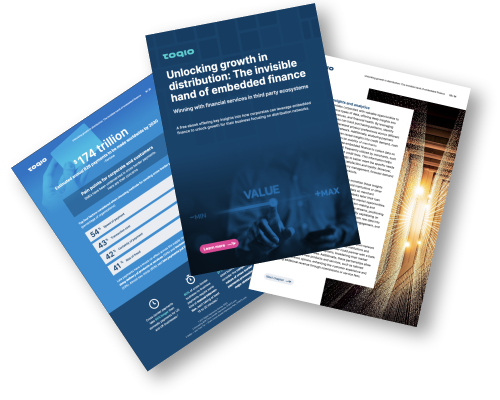2024: A year of transformation in the financial landscape

The financial sector in 2024 experienced profound changes throughout payments, regulations, and banking, driven by technological advancements, evolving consumer behaviours, and a complex regulatory environment.
Payments: Digital dominance and innovation
The global payments industry processed 3.6 trillion transactions in 2024*, totaling USD 1.9 quadrillion in value and generating a revenue pool of USD 2.5 trillion. The sector grew at an annual rate of 5% from 2019 to 2024, with projections indicating sustained growth over the next five years. For insights on six trends shaping finance, see McKinsey’s report: "Global Payments in 2024."
The case for B2B embedded finance in sales and end-customer distribution is compelling. Its importance and inevitability cannot be overstated: it offers a transformative solution, removing barriers that currently hold businesses back from realizing their full potential.
According to Eva Ruiz, Visa's Southern Europe Head of Fintech, New Digital Partners, and Crossborder:
In 2024, innovation in payments accelerated as businesses prioritized digital-first solutions and cross-border capabilities. Visa continues to play a pivotal role in shaping this evolution, enabling seamless transactions and empowering businesses to explore emerging opportunities like embedded finance.
Digital wallets and mobile payments reached record adoption, with consumers embracing contactless transactions for convenience and security. Regulatory bodies responded with enhanced oversight: in November 2024, the U.S. Consumer Financial Protection Bureau (CFPB) finalized a rule to supervise tech giants processing over 13 billion transactions annually, aiming to safeguard consumer interests.
Regulations: Strengthening oversight and compliance
Regulatory bodies intensified efforts to ensure transparency and consumer protection. In the UK, the Financial Conduct Authority (FCA) consulted on extending the timeframe for lenders to handle complaints regarding non-disclosed motor finance commissions, following a Court of Appeal ruling that deemed such commissions unlawful without customer consent. This move aimed to address potential compensation claims and maintain market integrity.
In the United States, the Federal Reserve proposed adjustments to capital requirements for large banks, aiming to enhance financial stability. These proposals, part of the "Basel Endgame," were modified following industry feedback, reducing the initially proposed capital buffer increase for global systemically important banks (GSIBs) from 19% to 9%, collectively saving banks approximately USD 100 billion. Read the details on Reuters.
Banking: Navigating challenges and opportunities
Banks faced a dynamic environment, balancing innovation with compliance. Santander UK set aside GBP 295 million to cover potential costs related to a court ruling against unlawful commissions paid to car dealers without customers' informed consent, reflecting the industry's focus on regulatory compliance. Simultaneously, banks explored embedded finance solutions to enhance customer experiences and open new revenue streams, leveraging technology to offer tailored financial services.
Liquidity, a key indicator for banks worldwide, was in the crosshairs of most financial institutions throughout the year. In fact, as per the European Central Bank's "Financial Stability Review" for 2024:
Euro area banks continue[d] to display resilience as liquidity positions and
solvency ratios, supported by organic growth from high bank profitability,
remain[ed] robust overall. The aggregate liquidity coverage ratio (LCR) of significant
institutions in the euro area rose above 160% in the fourth quarter of 2023, despite the
repayment of more than 80% of borrowed targeted longer-term refinancing operation
(TLTRO) funds over recent quarters.
For more insights, we also recommend taking a look at the IMF's "Global Financial Stability Report" for 2024.

Embedded finance: A strategic growth tool
Embedded finance emerged as a key strategy, with banks and corporates leveraging it to unlock new revenue streams and deliver smarter, faster solutions. By integrating financial services into non-financial platforms, businesses aimed to enhance customer engagement and streamline operations, positioning themselves competitively in the evolving market.
Looking ahead
As 2024 draws to a close, the financial sector stands at a crucial turning point. The intersection of technology, regulation, and evolving customer needs will define the road ahead. To succeed, businesses must embrace innovation and adapt to the challenges of a rapidly changing environment.
2025 is the year to act. With the right platform, businesses can unlock new revenue streams, streamline operations, and deliver transformative financial solutions.
At Toqio, our platform gives you the power to lead. Flexible, efficient, and built for growth, it’s the foundation to help your business thrive in the next era of finance. Ready to take the next step? Let’s build the future together.
*Note: These figures are extrapolations and will be updated once official 2024 data becomes available.
